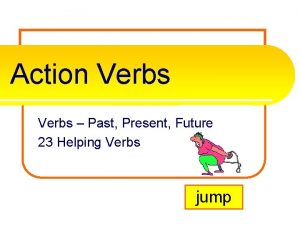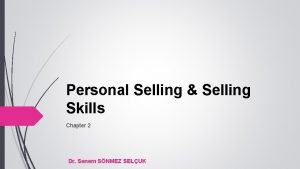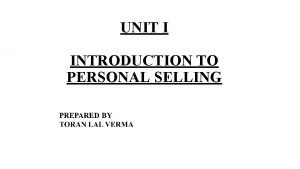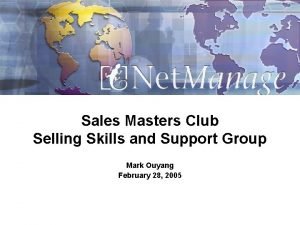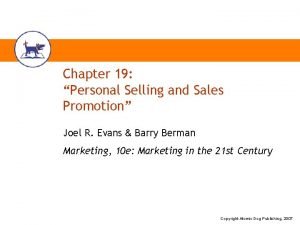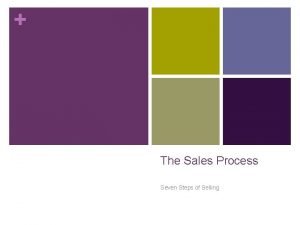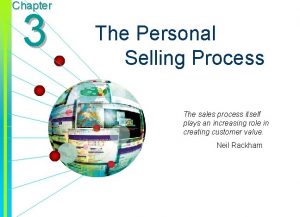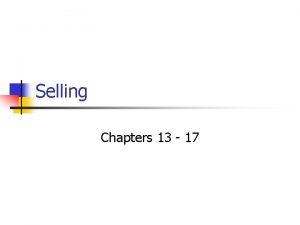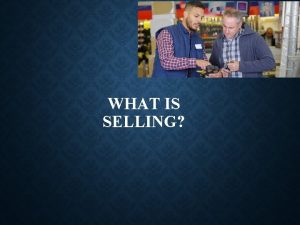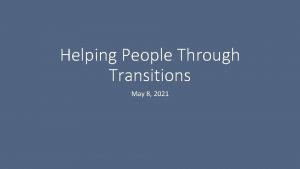Selling Techniques Selling The process of helping people








- Slides: 8

Selling Techniques Selling: The process of helping people access the information, products, and services they need to meet their personal and business goals Written by Dallas Duncan and Dr. Frank B. Flanders June 2010

Why People Buy n n People buy because of a perceived need Abraham Maslow’s Hierarchy of Human Needs: n Physiological: Survival needs n Security: Safety, both physical and financial n Social: Acceptance, belonging to a group n Self-Esteem: Desire for respect from others n Self-Actualization: Sense of self-worth or accomplishment n Most complex human need

How People Buy Customer becomes aware of a real or perceived need or problem n Customer researches information about his problem and what can solve it n Customer compares and contrasts how different products would solve his problem n Customer chooses a product to try n Customer evaluates his purchase to decide if it was a good idea or a poor buy n

Value and Worth Customers buy value n Value is thought of differently by each individual; it is a relative concept n Value depends on the perceived product performance, price, and additional services n Worth is an actual monetary amount, though consumers’ understanding of value makes them believe something is worth more than another alternative n

Opening the Sale n n Create a positive impression n Treat customers the way they want to be treated n Meet basic expectations of the relationship n Follow cultural and behavioral norms Get the customer’s attention Begin a relationship with the customer Customers expect… n Proper attire: If you’re going to a farm, don’t wear a business suit n Prompt arrival and cheerful greeting n You to be involved and enthusiastic in the conversation

Handling Resistance n n n Always accept objections and resistance as valid and treat them seriously Accept blame for any misunderstanding Anticipate and answer common objections in your presentation before your customer can bring them up Be empathetic Turn the objection into a selling point n n “Well, I know it’s expensive, but it will be a good investment because it lasts for 20 years. ” Listen to your customers vent!

Closing the Sale n n n Every call has a close—the moment when customers commit to either buying or not buying your product Trial Close: Ask for general agreement to help customer imagine the sale Direct Close: Ask the customer for his business Summary Close: Briefly summarize the major points of your discussion Choice Close: Offer customer a small, easy choice n n n “Would you rather buy 10 doses of this vaccine or the full 20 pack? ” Assumed Close: Begin planning together Special Features Close: Add something extra right when you ask for a sale

Successful Selling Strategies n n n Remember– People won’t buy if they don’t like you Thank people for their time, whether they buy or not Have a demonstration or sample of your product available Hand out your point-of-sale materials and brochure Listen to what your customer needs and wants!
 Action verbs past present future tense
Action verbs past present future tense Advantages and disadvantages of personal selling
Advantages and disadvantages of personal selling Types of selling situations in personal selling
Types of selling situations in personal selling Professional selling skills miller heiman
Professional selling skills miller heiman Buyer seller dyad
Buyer seller dyad Les fonctions techniques et les solutions techniques
Les fonctions techniques et les solutions techniques Value selling process
Value selling process Seven steps of personal selling
Seven steps of personal selling Personal sales process
Personal sales process
